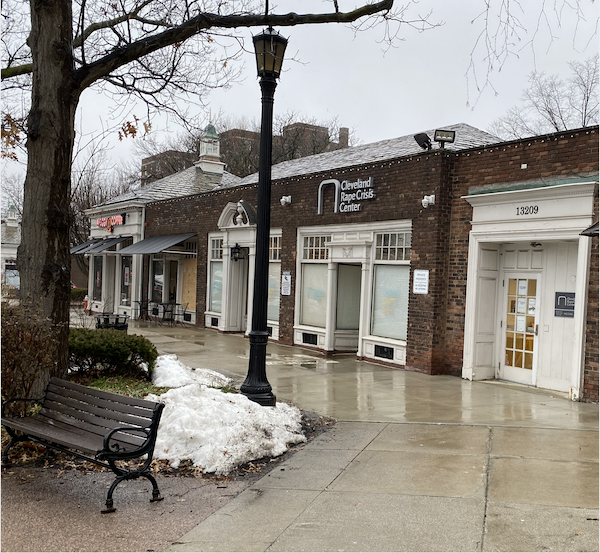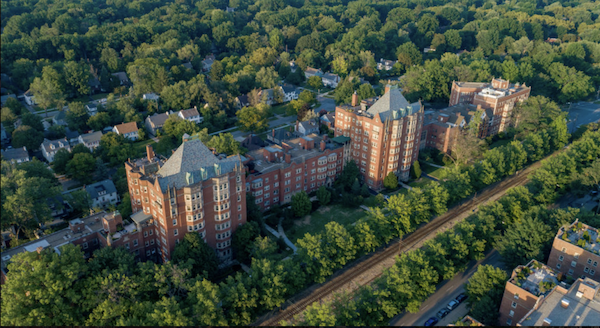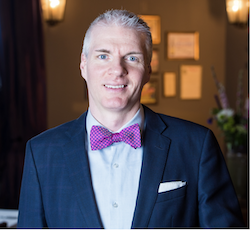
Shaker Square, NE Quadrant [February 17, 2022]
Towards the end of Cleveland City Council’s 2021 session, legislation was introduced to rescue Shaker Square from receivership to stanch its deterioration and create value to facilitate its future sale. At its essence, the ordinance authorizes the Director of Economic Development to enter into a loan agreement(s) with New Village Corporation, a subsidiary of the nonprofit Cleveland Neighborhood Progress, to partially finance the purchase of Shaker Square under the terms set forth in the Executive Summary to the Finance Committee.
Those terms provide for two low interest loans of $6 million each. The first loan has a 5-year term, interest only, renewable at the City’s option. The second, subordinate loan, has a 10-year term, is also renewable at the City’s option, and is forgivable at the City’s option upon fulfillment of specific criteria, the most important of which is the property’s sale to a City approved buyer. (Hold on to this detail because you will need it later in the story.)
The legislation had the support needed to pass under emergency ordinance pursuant to Council rules. Instead, it got stalled in committee where it resides to this day.
How did a solution that had the support of 16 of 17 council people at the time end up back to square one at the 11th hour?
The answer is rooted in both the founding of Shaker Square nearly 100 years ago and in the more modern-day politics of division.
On one side stand those who advance the zero-sum proposition that if Shaker Square is rescued with public money, then “needier” more “deserving” sections of Ward 4, will be deprived of resources. On the other are the nonprofit community development corporations and City of Cleveland entities charged with developing and stabilizing the Buckeye-Shaker-Larchmere neighborhoods.
If the real issue is the perennial one of the haves vs. the have nots as espoused by the faction opposed to the legislation, what about the equally persistent question of capitalism vs. the common good? And how does the culture of distraction and division in pursuit of personal advantage undergird the entire conversation?
Shaker Square was built as the gateway to Shaker Heights Village, an elite, suburban enclave developed by the Van Sweringen brothers. The property itself sits in Cleveland’s Ward 4 Buckeye-Shaker area and is adjacent to the Ward 6 Larchmere commercial district and the suburb of Shaker Heights.

Moreland Courts
Shaker Heights was the brothers’ version of utopia. Exclusivity was maintained through strict zoning that at the time prohibited apartment buildings and commercial properties. As was also the norm then, discriminatory covenants were embedded in property deeds that placed restrictions on resale to keep out “undesirables”, not so veiled code for black people.
Almost a decade after incorporating Shaker Heights, the “Vans” began work on the Moreland Courts project, a luxury mixed use residential and commercial development in Cleveland just west of the Shaker Heights border on Shaker Blvd. That project included what we now know as Shaker Square. Moreland Courts remains a prestigious address in Ward 4 with an undeniable aura of wealth.
At its inception, Shaker Square was intended as the back yard of the Moreland Courts apartments and as the playground of the privileged white residents of Shaker Heights. Upscale retail stores, restaurants and services dominated the commercial space for decades, anchored by a movie theater. But today, nearly one hundred years since its 1929 opening, the Square’s character and commercial mix have changed markedly from its founders’ vision, in large measure as a by-product of the new demographics of its adjacent neighborhoods.
The legacy of Shaker Square as both connector and divider continues to this day, even as the city of Shaker became more racially diverse, and the nearby Cleveland Buckeye neighborhood far less so.
Former Ward 4 city council member Ken Johnson was adept at exploiting that contradiction. He maintained his near 40-year councilmanic tenure not by spreading the wealth, but by pitting the poorer, mostly black residents of greater Ward 4 against the wealthier, largely white residents of Moreland Courts. Johnson propagated the fiction that “they” are somehow responsible for the rest of Ward 4 not getting its fair share.
Eventually, if you’re told you’re a duck often enough, you start quacking.
Against this backdrop it was predictable, if not entirely inevitable, that the Johnson playbook of “them” vs. “us” would be trotted out in the 4th quarter of a new game.
Opponents of public funds to save Shaker Square from foreclosure assert the need to protect the interests of the have-nots from the public-money-grab by the haves of Moreland Courts. Their leader is Shaker Square resident and nonprofit CEO, Brandon Chrostowski, founder of EDWINS, a reentry program housed there and on nearby Buckeye at E 130th Street. Chrostowski’s nonprofit has revitalized that gateway to the Buckeye Road commercial district by methodically acquiring and rehabbing properties on both Buckeye and South Moreland roads.
The main assertions of this group are that by extending “$12 million in forgivable” loans to New Village Corporation to stabilize the position of Shaker Square as the anchor of the Southeast side, the city is paying double what the property is worth, thus depriving other parts of Ward 4 — Mt. Pleasant and Kinsman — funds needed for coats for kids, meals for kids, lead abatement et. al. (Readers will remember from earlier in this story that only the second subordinate loan of $6 million is forgivable. The first loan of $6 million, which is what the property is currently worth, must be paid back to the City in full.)
They also condemn the so-called rushed process of ushering the legislation through the committee process, accusing the other side of invoking the “boogie man is coming!” to create a nonexistent crisis.
“‘We have to get this done now’,” is misleading, Chrostowski contends. “There is no rush.” Incongruously, the faction also supports allowing the property to go to foreclosure where free-market forces prevail but also has the potential to leave another scar on a district riddled with derelict properties.

Brandon Chrostowski
To win support for his stance, Chrostowski penned the week before Christmas a passionate op-ed published in the Plain Dealer enumerating the above altruistic-based opposition to the proposed legislation. What was absent from the op-ed, however, was any reference to Chrostowski’s personal stake in defeating the proposed ordinance.
Basking in the glow of recent national exposure, Chrostowski wants to recreate the Square in the image of EDWINS by transforming it into the social enterprise capital of the nation. “Few places or spaces have what Shaker Square has,” he reasoned. “We built a national model with EDWINs that can set the example for the rest of the nation.”
The only obstacle keeping Shaker Square from fully realizing its potential, according to Chrostowski, is the right leadership. But his early bid to acquire the property out of receivership was rejected. If the Cleveland plan to use New Village Corporation to re-imagine and redevelop the Square is thwarted, Chrostowski might reemerge as the lenders’ best or only alternative to be made whole.
Whether the omission of Chrostowski’s personal agenda was intentional or an oversight, it nonetheless paints a more complex scenario that forces the question of motive: Does one man’s personal interest in buying Shaker Square to extend his brand nationally and his real estate holdings locally align with the message he has been promulgating to the most vulnerable residents of Ward 4? Or does it echo the Ken Johnson playbook of pitting neighborhood against neighborhood to distract from his personal agenda?
Incidentally, Johnson himself lived in the Shaker Square footprint up until he was removed from office and made an involuntary federal guest for his rerouting of federal funds incarcerated in 2021 for crimes linked to theft of federal dollars earmarked for the revitalization of the Buckeye and Kinsman neighborhoods.
In Part II, appearing in this space tomorrow, we will report on our interviews with key participants in the debate over Shaker Square’s future, including City Council President Blaine Griffin, Joy Johnson of Burten Bell Carr Development, and Terri Hamilton Brown of New Village Corporation.
• • •• • •
RELATED:














